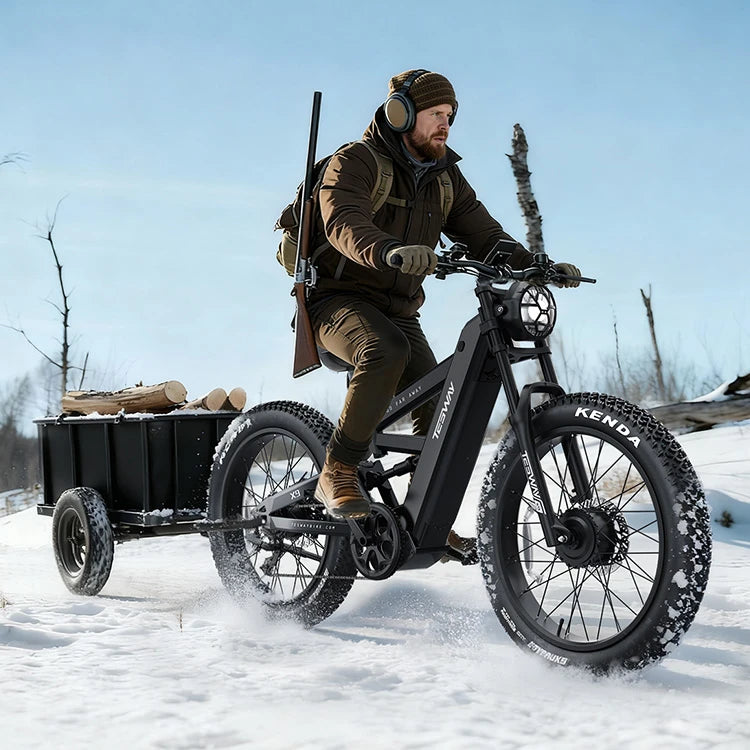Many people think that if they’ve never mastered riding a regular bike, they won’t be able to handle an electric one either. The fear of not having good balance can be a real hurdle.
But here’s the good news: riding Ebike is actually a lot easier than most expect.
Thanks to the motor assistance, it helps you maintain stability, tackle hills, and cover long distances without breaking a sweat.
Sure, it takes a bit of practice, but with the right techniques, you’ll be cruising in no time.
By following this step-by-step guide, you’ll feel confident in no time.
Step 1: Choosing the Right Electric Bicycle
Before you hop on any eBike, it’s important to select the one that’s suited to your needs.
Electric bikes come in different styles, sizes, and features, and knowing which one fits your preferences will make all the difference in your riding experience.
-
Commuter Bikes: Ideal for daily city rides, equipped with medium-range motors and designed for comfort.
-
Mountain Bikes: Built for off-road adventures, these come with durable tires, suspension systems, and more powerful motors.
-
FoldingBikes: Portable and convenient, perfect for city dwellers who need to stow their bikes in small spaces.
-
Fat Tire Bikes: Excellent for rough terrain, snow, and sand, providing extra stability with oversized tires.
City commuters may prefer lightweight, nimble bikes, while outdoor enthusiasts might gravitate towards mountain or fat-tire models.
If you’re looking for something dependable, Tesway’s eBikes are a solid choice to get you where you need to go—whether that’s through the city or out in the wild. Check out their lineup and see which ride suits your style best!

Step 2: Familiarizing Yourself with the Controls
Once you have your eBike, it’s essential to get comfortable with its controls.
These differ slightly from traditional bicycles due to the addition of the motor, battery, and throttle.
-
Pedal Assist: This mode allows the motor to assist you as you pedal. The harder you pedal, the more power is delivered to the wheels.
-
Throttle: On some bikes, you can accelerate using the throttle without pedaling.
-
Display Panel: Most electrical bikes feature an LCD panel showing important data like speed, battery level, and pedal assist mode.
-
Gears: Electric bikes often come equipped with multiple gears, allowing you to adjust resistance and motor assistance as needed.
Before hitting the road, spend some time familiarizing yourself with how the throttle and pedal assist levels work in conjunction with the gears.
SEE ALSO The BAFANG Motor: Powering Your Tesway Adventure
Step 3: Safety Gear and Preparation
Electric bikes can travel at much higher speeds than traditional bikes, so it’s crucial to gear up appropriately.
-
Helmet: A properly fitting helmet is a must to protect your head in case of a fall.
-
Protective Clothing: Wear clothing that provides some protection, such as padded gloves, long sleeves, and knee pads, especially for off-road rides.
-
Lights and Reflectors: Ensure your eBike is equipped with front and rear lights for visibility, especially when riding in low-light conditions.
-
Mirrors: Add rearview mirrors to keep track of surrounding vehicles and obstacles.
-
Brakes Check: Test your brakes before every ride to ensure they're responsive, especially since electric bicycles tend to be heavier.
Step 4: Start on Flat, Open Terrain
When you’re first learning to ride your eBike, start in a flat, open area away from traffic or crowded paths. A parking lot or a wide park pathway is ideal.
-
Begin by mounting your eBike while it's powered off. Get a feel for its weight and balance, as ebikes can be heavier than traditional bicycles.
-
Next, switch on the power and start with the lowest level of pedal assist. Begin pedaling slowly to feel how the motor engages.
-
Gradually increase the pedal assist level as you become more comfortable, and practice stopping and starting.

Step 5: Master the Braking System
Proper using your eBike's brakes is crucial for maintaining control, especially at higher speeds. Electric bikes are often fitted with disc brakes or hydraulic brakes to handle the extra weight and momentum.
-
Front and Rear Brakes: Always apply both brakes when stopping, but lead with the rear brake to prevent sudden stops that could send you over the handlebars.
-
Braking Distance: Because electric bikes are heavier, they require longer distances to come to a complete stop. Practice slow stops from different speeds.
-
Downhill Braking: If riding downhill, control your speed by lightly squeezing the brakes to avoid overheating the brake pads.
Step 6: Practice on Different Terrains
Once you’re comfortable on flat ground, challenge yourself by riding on hills, gravel, and uneven terrain. This will give you a feel for how the motor assists and how to control the bike in different conditions.
-
Uphill Riding: Engage a higher level of pedal assist to help with climbing steep inclines. Shift to a lower gear to make pedaling easier.
-
Downhill Riding: Use both brakes to control your speed and remain in a pedal-assist mode for greater stability.
-
Off-Road Terrain: For off-road adventures, switch to a mountain or fat tire eBike. Keep a low center of gravity and be prepared to adjust the pedal assist as needed.
Step 7: Maximizing Battery Life
Learning how to manage your eBike’s battery efficiently can greatly enhance your riding experience and extend your range.
-
Plan Routes: Pre-plan your routes to include charging stops if you’re riding long distances.
-
Pedal More: Use a lower pedal assist setting to conserve battery, especially on flat or downhill stretches.
-
Use Eco Mode: Many electric bicycles feature an Eco Mode, which provides the least motor assistance but conserves the most energy.
Pay attention to the battery level on the display, especially if you plan to cover long distances.
Step 8: Riding in Traffic
Riding in traffic is one of the more challenging aspects of cycling, but with the added speed of an eBike, you can better keep up with the flow of cars. Follow these tips for a safer commute:
-
Stay Visible: Wear bright clothing and make sure your eBike has working lights and reflectors.
-
Signal Clearly: Always use hand signals to indicate your turns, and be cautious of drivers who may not see you.
-
Keep to the Right: In most cities, cyclists are required to ride on the right-hand side of the road. Stick to bike lanes where possible.
Step 9: Regular Maintenance
To keep your eBike in top condition, perform regular maintenance checks. Keeping your bike well-maintained not only ensures your safety but also prolongs the lifespan of your components.
-
Tire Pressure: Keep your tires inflated to the recommended pressure levels. Under-inflated tires can increase resistance and reduce battery efficiency.
-
Chain Lubrication: Electric bikes go through chains faster than traditional bikes, so it’s important to lubricate the chain regularly.
-
Brake Pads: Monitor brake pads for wear and replace them when necessary.
Conclusion
Learning to ride an eBike the right way is all about preparation, practice, and understanding how the additional features like motor assistance and battery power work in harmony with your cycling skills.
By following the steps in this guide, you’ll not only feel more comfortable on your eBike but also become a confident rider who can navigate various terrains and traffic conditions with ease.
FAQs
Can you ride electrical bikes in extreme weather conditions?
This guide focuses on riding techniques but doesn’t cover weather-specific advice. For extreme weather, it’s essential to look into waterproof eBikes or additional protective gear for the battery and motor.
How long does an electric bike battery typically last?
Though this article discusses maximizing battery life, it doesn’t give specific numbers. Battery life varies depending on the model, capacity, and how you ride. Most eBike batteries last between 20 to 60 miles on a single charge.
Do I need insurance for my Ebike?
While riding tips are detailed, the article doesn’t mention eBike insurance. Check local regulations as some areas may require insurance for certain eBikes, especially those with higher speeds.
Related Articles
Tesway E-Bikes: Your Ultimate Festive Fitness Companion
Navigate Holiday Hustle with Tesway Electric Bikes: Your Traffic Solution
Electric Bike Guide: How to Choose the Perfect Electric Bike for You







![How to Ride an Ebike the RIGHT and EASY Way [Step by Step for Beginners]](http://ca.teswaybike.com/cdn/shop/articles/E55A1910.jpg?v=1725591356&width=1000)
Share:
Navigate Holiday Hustle with Tesway Electric Bikes: Your Traffic Solution
How Electric Bike Works